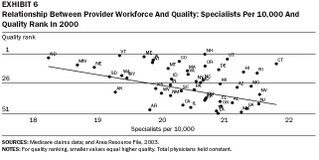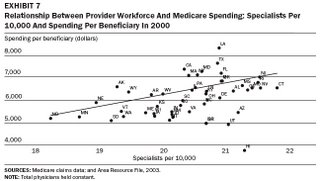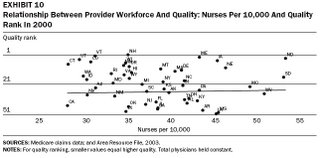Some Medicare beneficiaries have already felt this on a personal level, as they have had difficulty finding a family doctor for their primary care needs. This is due to the fact that Medicare funding for the services provided by family physicians often does not cover the actual cost to the doctor of providing that care! In fact, according to a 2006 report from the American College of Physicians, "Primary care is on the verge of collapse. Very few young physicians are going into primary care and those already in practice are under such stress that they are looking for an exit strategy". The report further notes that the key contributor to the problem they describe is the "inadequate and dysfunctional payment policies" of the government and insurance companies. "Unless immediate and comprehensive reforms are implemented by Congress and CMS (Medicare), primary care - the backbone of the U.S. healthcare system - will collapse," concludes the report. "The consequences will be higher costs and lower quality as patients find themselves in a confusing, fragmented, over-specialized system in which no one physician accepts responsibility for their care, and no one physician is accountable to them for the quality of care provided."
The problem described in this report is very familiar to your family doctor, and all of us here in my practice at Family Care Network (FCN). A Family Medicine practice is really a small business which simply cannot remain viable if revenue does not exceed expense. If the current inadequate and dysfunctional Medicare payment policies continue, and with the Medicare population about to increase dramatically, doctors will have no choice but to close their practice to Medicare patients. It is simply not possible for physicians to subsidize the care of so many without becoming economically non-viable. This is a terrible prospect, at the very time when the need will be the greatest! I believe that this is unacceptable, and that is why I am sharing this information about steps we are taking in my medical group, The Family Care Network Solution.
Family Care Network (FCN) has been working diligently to bring this crisis to the attention of our elected officials. While we sincerely hope that our State and Federal Governments will eventually address this crisis on both a national and local level, we have taken a position that FCN must seek out a more immediate solution to ensure our long term viability for survival.
FCN has developed a long term strategic plan for Medicare which we believe will enable us to:
1. Remain in Practice.
2. Continue practicing family medicine according to the Personal Medical Home model of health care as advocated by the American Academy of Family Physicians (AAFP) (see next page).
3. Continue providing care for our existing Medicare Patients.
4. Care for existing patients who become Medicare eligible.
5. Accept new Medicare patients into our practice (beginning in 2007).
The central component to the FCN Medicare Strategy is partnering ONLY with Medicare insurance companies that recognize the critical role played by family medicine in the overall health care system, and choosing ONLY insurance partners that financially support the "Personal Medical Home" as advocated by the AAFP and ACP.
We realize that patients have different needs and preferences when it comes to their Medicare health insurance. As such, FCN will provide our patients with access to multiple Medicare insurance plan options. We also recognize how confusing Medicare insurance has become and therefore FCN will provide insurance counseling services at no cost to our patients. Licensed insurance professionals well versed in all of the various Medicare insurance plans accepted by FCN, will be on-hand to help you understand your options and enroll in the Medicare insurance plan that is best suited to your personal needs.
Finally, FCN believes that healthy communication correlates directly to healthy patients. FCN requires that all Medicare insurance company partners provide internet connectivity between patient and provider via the DocInTouch web messaging program, at no cost to the patient. DocInTouch is a secure internet-based service that enables patients and physicians to communicate efficiently and effectively, and this type of functionality is part of the personal medical home concept.
The Personal Medical Home
All physicians and staff at FCN firmly embrace and support the Personal Medical Home model of health care advocated by the American Academy of Family Physicians (AAFP). FCN supports the Personal Medical Home in the following ways:
1. The physician makes a commitment to the patient to know them as a person, and to provide ongoing, continuity of care for illness and injury, as well as medical planning and advice for screening for illnesses and maintenance of good health.
2. Our office team shares this commitment, assisting the physician in providing hospital care, home care and consultation when needed.
3. Maintain accurate medical records for the care delivered and provide patient education using current technology.
4. Maintain patient registries for certain chronic diseases (Diabetes, Congestive Heart Failure) in order to study, monitor and improve the adequacy of their care, as well as to seek out patients who have not received needed care.
5. Provide planned chronic care visits for diabetes and other appropriate conditions, so that needed information is present for treatment and education at the time of the visit.
6. Integrate patient feedback to improve the performance of the practice.
7. Implement the “New Model of Family Medicine” described in the Future of Family Medicine Report, including secure web messaging.
As we communicate with our patients about these changes, we are letting them know that we greatly appreciate their continued support and patronage. Providing their Personal Medical Home is something that we take very seriously and we remain fully committed to providing the absolute best primary care medicine possible. We recognize that re-evaluating Medicare insurance needs involves significant effort, time and stress. We hope that they understand the challenge we are currently facing, but with stheir support we are confident that we will overcome this challenge, together.







